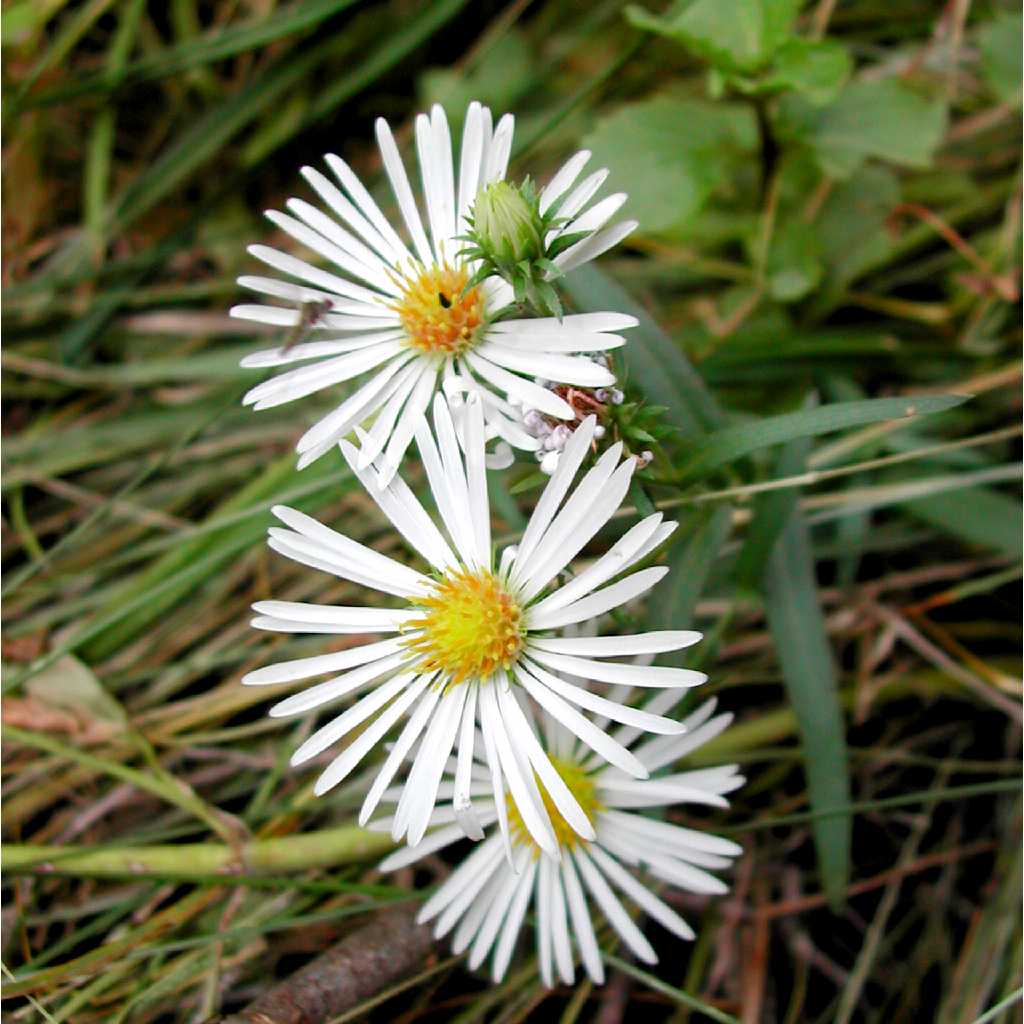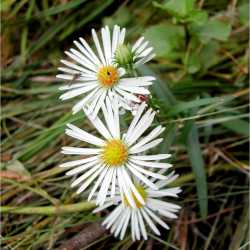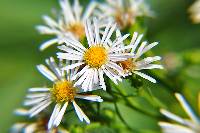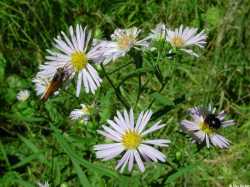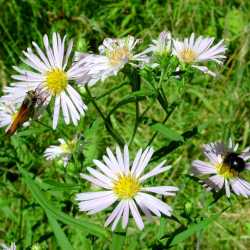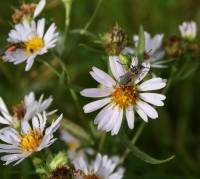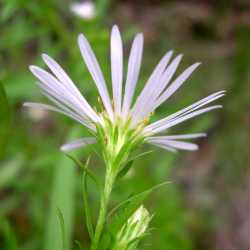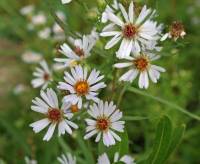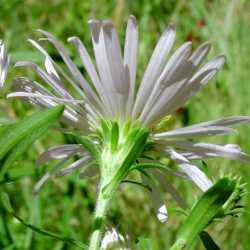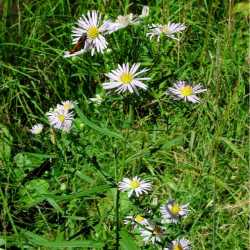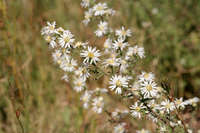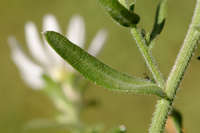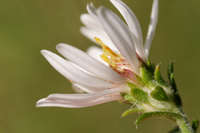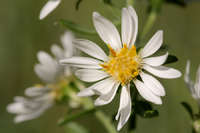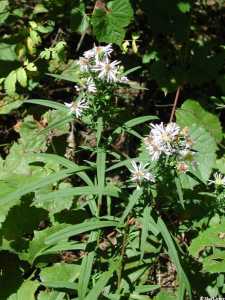Perennials, 30-150(-200) cm, colonial; long-rhizomatous (rhizomes usually white, thick, contorted). Stems 1, erect (straight, stout), glabrous or hairy. Leaves thin, scabrous, apices mucronate, abaxial faces glabrous (vein areoles indistinct, elongate), adaxial glabrous or sparsely scabrous (var. hesperium); basal withering by flowering, petiolate to subpetiolate (petioles winged, ciliate, bases dilated, sheathing), blades elliptic-oblanceolate or obovate to suborbiculate, 10-80 × 5-20 mm, cuneate to attenuate, margins crenate-serrate, apices acute to obtuse or rounded; proximal cauline withering by flowering, sessile or subsessile, blades lance-ovate or oblanceolate to linear-lanceolate, (40-)50-150 × (3-)10-20(-35) mm, progressively reduced distally, bases cuneate, ± decurrent, margins serrate, apices acute to acuminate; distal sessile, blades oblanceolate to linear, 30-100(-140) mm, only slightly reduced distally, bases cuneate, margins entire. Heads in ample or diffuse to narrow, elongate, leafy, paniculiform arrays, branches ± ascending, rarely secund, branch leaves often longer than pedicels. Peduncles 0.5-5 cm, ± pilose, bracts 1-3(-5), linear-oblanceolate to -lanceolate, foliaceous, ciliate. Involucres campanulate to cylindric, 3-8 mm. Phyllaries in (3-)4-6 series, appressed or slightly spreading, linear-lanceolate to linear (innermost), sometimes slightly dilated distally, ± strongly unequal to subequal (var. hesperium), bases indurate 1 / 4 - 1 / 2 , margins scarious, erose, hyaline, sparsely ciliolate, green zones lanceolate to linear-lanceolate, outer sometimes foliaceous (particularly var. hesperium), apices acute to acuminate (outer) or acuminate to caudate (inner), mostly mucronulate, abaxial faces glabrous, adaxial sparsely strigillose. Ray florets 16-50; corollas white to pinkish or pale blue-violet, laminae 3-10(-14) × 0.5-1.3 mm. Disc florets (13-)20-40(-52); corollas yellow becoming purple, 2.8-5.8 mm, tubes shorter than funnelform throats, lobes sometimes ± spreading, triangular, 0.4-1.2 mm. Cypselae gray or tan, obovoid, ± compressed, 1.5-2 mm, 4-5-nerved, faces sparsely strigillose; pappi white to sordid or tawny, 5.5-6 mm.
Varieties of Symphyotrichum lanceolatum are sometimes grouped into two subspecies: subsp. hesperium (var. hesperium) and subsp. lanceolatum (the other four varieties). J. C. Semple and J. G. Chmielewski (1987) provided maps of the five taxa. The ranges of var. hesperium and var. lanceolatum overlap in the prairies and in the boreal zone from Alberta to the Clay Belt of northern Ontario. The ranges of the other three varieties do not overlap with that of var. hesperium, but they all overlap each other and with var. lanceolatum in the Midwest. The ecology and cytogeography of the species were summarized by Chmielewski and Semple (2001). The name Aster tradescantii has sometimes been misapplied to this species.
Duration: Perennial
Nativity: Native
Lifeform: Forb/Herb
General: Perennial herbs, 30 to 150 cm tall, from long rhizomes, forming colonies; stems sparsely hairy, usually in lines.
Leaves: Basal leaves withering before flowering, the blades elliptic-oblanceolate to obovate, 1-8 cm long and up to 2 cm wide, with crenate-serrate margins; stems leaves alternate and sessile, the bases clasping or subclasping the stem; blades of stem leaves lance-ovate to oblanceolate or linear, 5-15 cm long and up to 2 cm wide (upper leaves reduced), margins of lower stem leaves serrate and margins of middle and upper leaves entire.
Flowers: Flower heads showy and radiate, white to lavender with yellow centers, arranged in leafy, open panicles; involucres campanulate to cylindric, 3-8 mm high, the bracts (phyllaries) in 4-6 graduated series, appressed or slightly spreading, straw colored with green tips; ray florets 16-50 per flower head, the laminae (ray petals) white to pale pink or purple, 3-10 mm long and 1 mm wide; disc florets yellow, becoming purple.
Fruits: Achenes gray or tan, obovoid, compressed, 2 mm long, 4-5-nerved, sparsely hairy; topped with a pappus of tan-colored capillary bristles, 6 mm long.
Ecology: Found along pond and creek margins, roadside ditches, and other wet areas, below 9,000 ft (2743 m); flowers July-October
Distribution: Throughout the US and most of CAN; south to n MEX
Notes: This wide-ranging wetland obligate is a rhizomatous perennial with lance-shaped leaves and panicles of white to purple daisy-like flower heads at the tops of the stems. There are a number of similar-looking perennial Symphyotrichums; here are the key characters so you can distinguish this one: there is a single series (row) of ray florets around the outside of each flower head, and the ray petals are greater than 1 mm long; stems and peduncles are not hairy all over, but have lines of hairs on them; outer phyllaries are linear-lanceolate, noticably shorter than the inner phyllaries; all phyllaries are straw-colored with a green spot near the tip, and not spine-tipped; flowers are in open panicles with leaf-like bracts on the peduncles; and the bases of the stem leaves clasp the stem, at least a little. There are 2 subspecies; ours is subsp. hesperium, found throughout western North America.
Ethnobotany: Used to treat fevers.
Etymology: Symphyotrichum comes from Greek symphysis for borne together and trichnos for hair, referring to the basally connected pappus bristles on the first described member of the genus; lanceolatum means lance-like.
Synonyms: Aster lanceolatus and many others
Editor: LCrumbacher 2011, AHazelton 2017
Colonial by long rhizomes; stems 6-15 dm, pubescent in lines above; lvs all cauline, lanceolate or lance-elliptic to linear, serrate or occasionally entire, glabrous or somewhat scabrous above, sessile or tapering to a petiole-like base, sometimes a little clasping, but scarcely auriculate, the main ones 8-15 cm נ3-35 mm, mostly not strongly reticulate, the areolae, if visible, generally irregular and longer than wide; heads ±numerous in an elongate leafy infl, the invol 3-6 mm, its bracts narrow, sharply acute to acutish, glabrous except for the sometimes ciliolate margins, ±strongly imbricate, with elongate, usually appressed green tip; rays 20-40, white or occasionally lavender or blue, 4.5-12 mm; lobes of the disk-cors comprising 30-45% of the limb; 2n=32, 48, 64. Moist low places; N.S. to N.C., w. to N.D. and Tex. (A. paniculatus, a preoccupied name; A. lamarckianus; A. simplex misapplied, the type apparently a garden hybrid of A. laevis and A. lanceolatus var.) Three vars.
Gleason, Henry A. & Cronquist, Arthur J. 1991. Manual of vascular plants of northeastern United States and adjacent Canada. lxxv + 910 pp.
©The New York Botanical Garden. All rights reserved. Used by permission.


